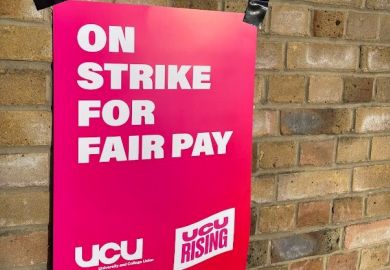UK vice-chancellors with a taste for Saturday morning lie-ins got a rude awakening last month. “University bosses erode our working conditions and then sleep like babies,” read a typically abrasive tweet from the University and College Union, accompanied by a picture of a large golden bed. “This weekend, let’s give them nightmares.”
Attempting to rally members to vote to back more strike action, the union has turned up the dial in its “us versus them” rhetoric of late, using Twitter to accuse leaders of dodging accountability while “raking in” high salaries.
But such a confrontational approach has led to disillusionment among some members, who say they feel it undermines the chances of reaching an agreement with those being vilified.
It has also landed general secretary Jo Grady in potential legal trouble. She faces being sued by the firefighter Paul Embery, who has successfully raised £24,000 to bring a case against her for publishing what he says was a “serious libel” against him on Twitter. UCU declined to comment on the allegations.
Aside from the specifics of this case, the merits of a combative approach on social media and beyond have divided members.
James Eastwood, chair of the Queen Mary University of London branch of UCU, said calling out his institution’s president, Colin Bailey, for his actions during the disputes had been effective. The publicity had helped the branch raise £70,000 to cover pay lost during the industrial action and the university stepped back from employing consultants to grade essays, he said.
“We think carefully about what we put on social media. But when the channels of communication within the university aren’t functioning, or when people pretend everything is normal, it matters to put the spotlight on practices that shouldn’t go unchallenged,” Dr Eastwood added.
Richard Harris, professor of quantitative social geography at the University of Bristol, said he supported the strikes and felt the actions of some vice-chancellors deserved to be called out, particularly given that they were so well paid.
But he felt there needed to be a conversation across the sector about how to finance higher education sustainably, and this was occasionally undermined by the sometimes “childish” vilification of vice-chancellors.
“The bottom line is that the sector is underfunded, and I am not sure I am comfortable with the union giving the impression that it has large liquid reserves that could be spent on salaries,” he added, referencing an oft-repeated union claim that universities are sitting on “£40 billion”.
Finn Pollard, associate professor in American history at the University of Lincoln, said that although he saw the need to present a “clear message”, he would also have liked to see some acknowledgement in the union’s communications about the varying financial health of institutions, with many facing course closures and job losses.
“I sometimes find it ironic – in the classroom we try to get students engaged with the complexities of problems but then, when we present ourselves externally, we do so in a very black-and-white way that obscures complexities that we are going to have to grapple with if we want a better sector,” he said.
Although the sector did have problems with leadership, Dr Pollard added, some of the “demonisation” of vice-chancellors had “obscured the very significant role that government and its funding frameworks play in determining the financial situation of the sector. I suspect the government is quite happy in that no responsibility seems to be passing to it for any of this situation.”
Dr Grady, for her part, said that it was “right” that vice-chancellors were “held accountable for a situation they have helped create”.
“Many vice-chancellors were involved in lobbying for today’s funding model and welcomed the lifting of student number caps. It is rich in the extreme for them to now distance themselves just when staff ask for their fair share,” she said.
But Dr Pollard said he felt that the confrontational approach often taken by UCU’s official accounts could empower some of the “pretty vicious” back and forth between different union factions seen on social media, which could lead to abuse on all sides.
Nick Hillman, the director of the Higher Education Policy Institute, who has on occasion borne the brunt of such barbs, said that he felt it undermined the idea that those in higher education should be able to “disagree well” and left the public with a “bad impression” of the union.
But industrial relations expert Gregor Gall said both sides in the disputes had accused each other of “misrepresentation” and what unions said publicly should be “taken with a pinch of salt” because messages were often framed to satisfy internal audiences.
“The wiser employers might recognise that such union messaging is an essential part of how a credible bargaining partner operates at a time of internal tensions. These wiser employers should be concerned only if the union messaging leads to a shift in the balance of power between themselves and the union or the balance of forces within a union. Neither of these seems particularly present at the moment,” Dr Gall said.
tom.williams@timeshighereducation.com
Like this story? Get more like it in your inbox – sign up to our newsletters.
Register to continue
Why register?
- Registration is free and only takes a moment
- Once registered, you can read 3 articles a month
- Sign up for our newsletter
Subscribe
Or subscribe for unlimited access to:
- Unlimited access to news, views, insights & reviews
- Digital editions
- Digital access to THE’s university and college rankings analysis
Already registered or a current subscriber? Login








